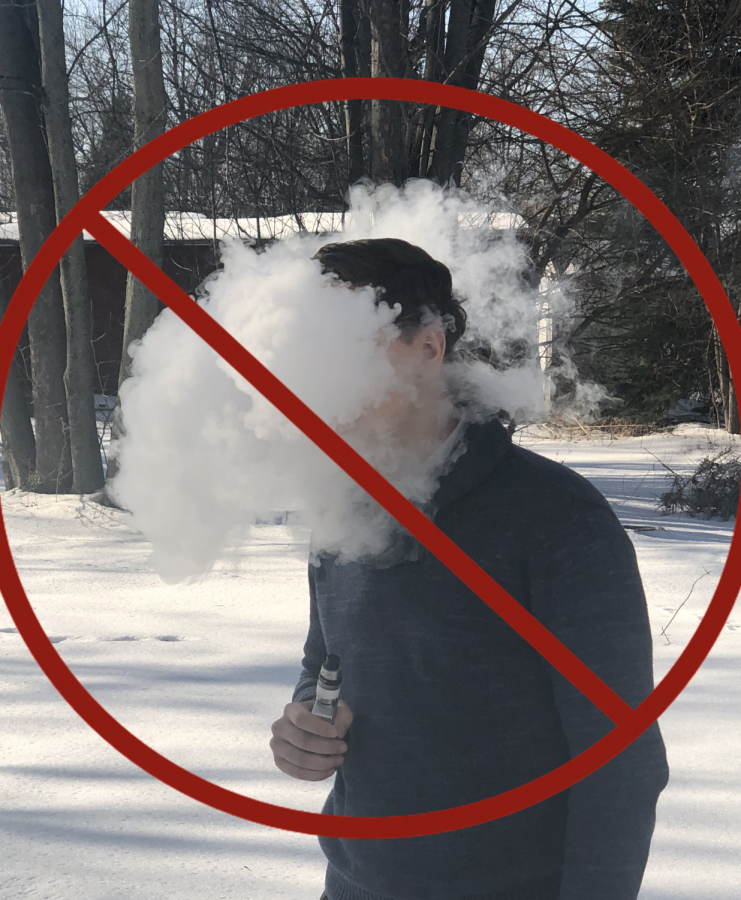Impacts of Vape
While it is legal for 18+ to smoke, GLHS strongly advises against it. There are absolutely no smoking devices allowed on school grounds.
March 3, 2019
Near the beginning of the 2018-2019 school year, the Grand Ledge Administration sent out an email informing parents about new guidelines regarding the use of ‘vapes’ by the student body. There is no question as to why they felt the need to shed light on these rules, but just how bad are these new devices for this generation of students?
The most popular products that teenagers nowadays seem to get their hands on ranges from Juuls to Suorins, to the variety of cheaper and lesser known versions of such, all of which contain nicotine. The growing trend is evolving quickly, making it easier for students to obtain them, as well as easier to hide, and a quicker buzz. In a National Public Radio interview, Richard Meich of local research institution the University of Michigan, who recently led a study regarding the effect of vaping on teens in Michigan, saw this incline as something to be taken very seriously.
“The policies and procedures in place to prevent youth vaping clearly haven’t worked,” Meich said. “New additional, vaping-specific strategies may well be needed in the years ahead in order to keep vaping devices out of the hands of the youth.”
According to Meich’s research, there was a nine percent spike in the usage of e-cigarettes amongst Michigan high school teens in comparison to the previous year’s (2017) 28 percent. The growth in accessibility as well as the widespread of flavors pull students towards the downward spiral that is addiction, and schools are at a loss as to how to stop the epidemic. Ken Wright, Assistant Principal of Grand Ledge High School, recognizes this as a serious issue. He, along with the rest of the administration are continuing to educate the student body on these matters.
“The message of nicotine dangers is communicated to our students in multiple ways starting in elementary school,” said Wright. “We plan to continue developing an educational approach so students understand the dangers of nicotine use in the form of vape devices and the highly addictive nature of nicotine in general.”
The use of e-cigarettes is well hidden and spread among all cliques and social groups, and the concealment of these devices and the constant access through the system embedded in the schools leave administration swinging with a blindfold on.
Numerous schools are taking the aggressive approach. Located not even ten miles down Saginaw Highway, Lansing Christian School’s students are left with no choice. With frequent nicotine testing, the students are more cautious as to what they put in their bodies.
“I do not see the process as effective,” said Nic Sura, a former student at Lansing Catholic. “I saw it more as a scare tactic than anything.”
Meanwhile, in Orange County, CA, teachers and educators are taking a very different approach. Social and Emotional Learning (SEL) looks to lessen the impact of the problem before it even starts by educating students on how to better cope with the problems life as a teenager will throw at everyone. Edutopia, a news site covering how schools are coping, examined the examples of ways that schools are coping with this widespread of young nicotine addictions through vape. From the most distressful stressors to daily hassles, Ryan Crowdis, the Tobacco Use Prevention Education manager in Orange County, is trying to give kids the information they need so they do not find themselves turning to the drug.
“They’re learning how to deal with social pressure, how to respond to family dynamics and stress,” Crowdis said. “Any young person can learn from that kind of information.”
In teaching kids how to properly wrap their heads around what can happen in their lives and how to cope with their stressors, they can better evaluate their situation. Crowdis’ program looks to educate students and create an anti-smoking community.
Grand Ledge’s approach leaves questions as to how well this will be enforced, how it will affect the student body, and if the impact will be positive in the long run. Numerous students, including those whom the new regulations will affect, and those who will not be more or less affected in one way or another, indicated a very apathetic or even annoyed response to what is being enforced.
“These new rules are not really doing anything,” said a Grand Ledge student. “So far I have not seen a single kid stop vaping, a few more getting in trouble maybe, but I do not think they are changing the attitudes of these kids at all. There probably won’t be a positive outcome, and overall no dip in the number of kids who use vapes.”
The fact of matter is, the social impact is not as changed in the long run just yet. However, with an increase in students who will receive punishment, there will hopefully be a growth in caution in using vapes.
“We are hoping that [the] long term effects of a continued message about this nicotine use will help,” said Wright.
Without a proper understanding of how to cope with peer pressure, the struggles of teenage angst, and the yearning to belong, the end of nicotine devices usage and other outlets may not be something this generation of students will see.

